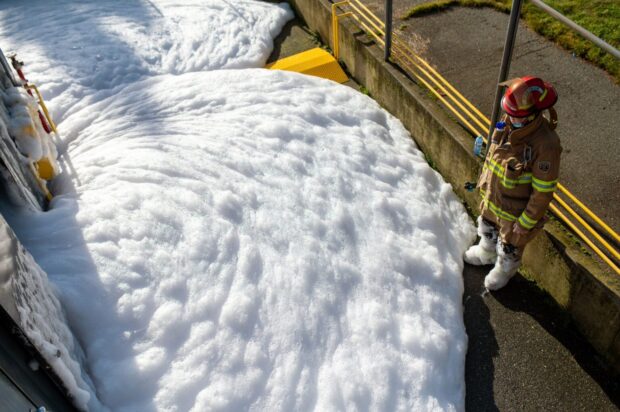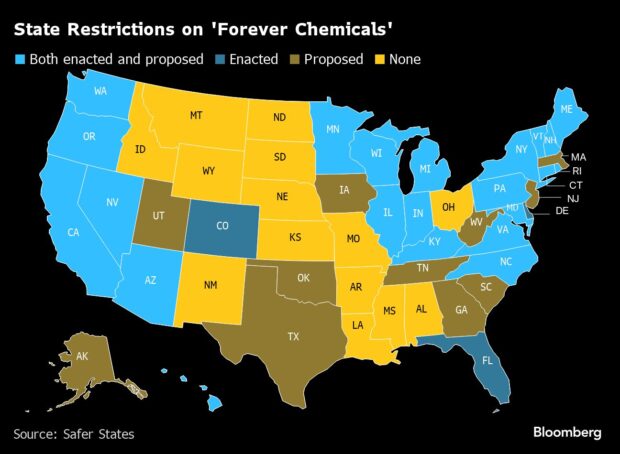As lawmakers around the world weigh bans of cancer-linked “forever chemicals,” many manufacturers are pushing back, saying there often is no substitute for the compounds.
Minnesota and Maine have passed legislation to effectively outlaw the use of per- and polyfluoroalkyl substances, or PFAS, in nearly all products by the early 2030s. Dozens of other states are also considering curbing their use. And the European Union’s Chemical Agency has proposed a widespread ban.
In response, Ford Motor Co. warned Maine state officials in May that “there is no commercially available technology that exists in the world today” that can replace a PFAS-containing thermoplastic used for electric vehicle batteries. Earlier this month, the U.S. Defense Department said that banning PFAS, used in weapons systems, information technology and machinery, “would greatly impact national security,” a view echoed by the U.S. Chamber of Commerce and other industry groups.
“These are critical chemistries that enable modern day life,” said Brandon Farris, vice president of domestic economic policy with the National Association of Manufacturers, a lobby group. “Many of them cannot be replaced.”
PFAS can provide elasticity, corrosion resistance and weather protection. Their ultra-strong carbon-fluorine bonds prevent these substances from naturally degrading, earning them the “forever chemicals” moniker. So, they accumulate in the environment. Studies have shown that nearly half of U.S. drinking water supplies contain at least one form of the chemical and PFAS is in the blood of about 97 percent of Americans.
The mounting body of evidence linking the chemicals to health risks for cancer, heart disease and miscarriage have prompted some governments to act.
Governments are weighing health concerns against other priorities. The Semiconductor Industry Association, a trade group representing Intel Corp., Nvidia Corp. and others, found that it would be “extremely difficult if not impossible” to replace PFAS in the chipmaking process, which could set back U.S. and EU efforts to support the sector amid mounting tensions with China.
While the federal government has not yet taken steps to broadly ban PFAS, state efforts to restrict its use are expanding. In May, Minnesota Gov. Tim Walz signed legislation banning the sale of carpets, rugs, cosmetics and other products containing PFAS starting in 2025. In 2032, the legislation will outlaw the sale of any product with intentionally added PFAS, unless the use is “unavoidable.”
One of the state’s biggest companies, manufacturing giant 3M Co., announced in December that it would stop making all PFAS, citing “accelerating regulatory trends.”
But lawsuits have also taken their toll. In June, 3M agreed to pay as much as $12.5 billion to resolve claims that PFAS it produced for firefighting foams polluted drinking water supplies across the U.S. It is now facing thousands of other lawsuits from its decades as one of the world’s dominant producers of PFAS and its products, such as Scotchgard waterproofing.
Growing consumer concerns are also a factor. Starbucks Corp. has pledged to eliminate all PFAS from packaging this year. And Patagonia Inc. has said it will fully eliminate PFAS from its water-repelling outdoor gear. But the firm’s early replacement attempts offer a preview of what others could face: They didn’t work very well.
Further complicating matters is that even if firms don’t themselves use PFAS in their products, they’ll still be affected by the restrictions if their suppliers do.
“Companies are going to need to look at what they make, figure out if it has PFAS in it and figure out if they can sell it if it has PFAS in it,” said Ken Rivlin, an attorney with law firm Allen & Overy LLP, who advises corporations on PFAS and other chemical restrictions.
This may not be easy, according to Farris of the National Association of Manufacturers.
“What we’re hearing now is, ‘We’ve never used PFAS, but we have gaskets in our facilities that have PFAS, so how much of a problem do we have?'” he said.
The Pushback
Because there are not now effective replacements for every role PFAS plays, industry lobbyists are pressing to make the rules less onerous.
Manufacturers contend that banning 10,000-plus PFAS compounds in one fell swoop is overly broad and argue instead for a more targeted approach based on the risks posed by specific compounds.
Companies are also pushing back on what they say are complex and challenging requirements to disclose all PFAS content in their products. In a sign of how tough it may be to implement, Maine delayed its PFAS reporting rule until 2025 after it granted thousands of temporary exemptions sought by companies.
Minnesota also has a law requiring that companies report which of their products contain intentionally added PFAS starting in 2026. Some are warning that governments may not be ready for what they’ll receive.
“I tried to prevail on our regulatory agency that you’re going to need a bigger parking lot,” said Tony Kwilas, director of environmental policy at the Minnesota Chamber of Commerce. “It’s truckloads of data that’s going to come in.”
Photo: PFAS substances can be found in firefighter foam, outdoor gear, artificial turf, medical equipment and countless other products/Bloomberg






















 What to Expect in 2026: U.S. P/C Results More Like 2024
What to Expect in 2026: U.S. P/C Results More Like 2024  Underwriter, Actuary Fears of AI Drop; Work Needed on Collaboration
Underwriter, Actuary Fears of AI Drop; Work Needed on Collaboration  Five AI Trends Reshaping Insurance in 2026
Five AI Trends Reshaping Insurance in 2026  How Insurers Can Avoid Post-Merger Technology Failure
How Insurers Can Avoid Post-Merger Technology Failure 




